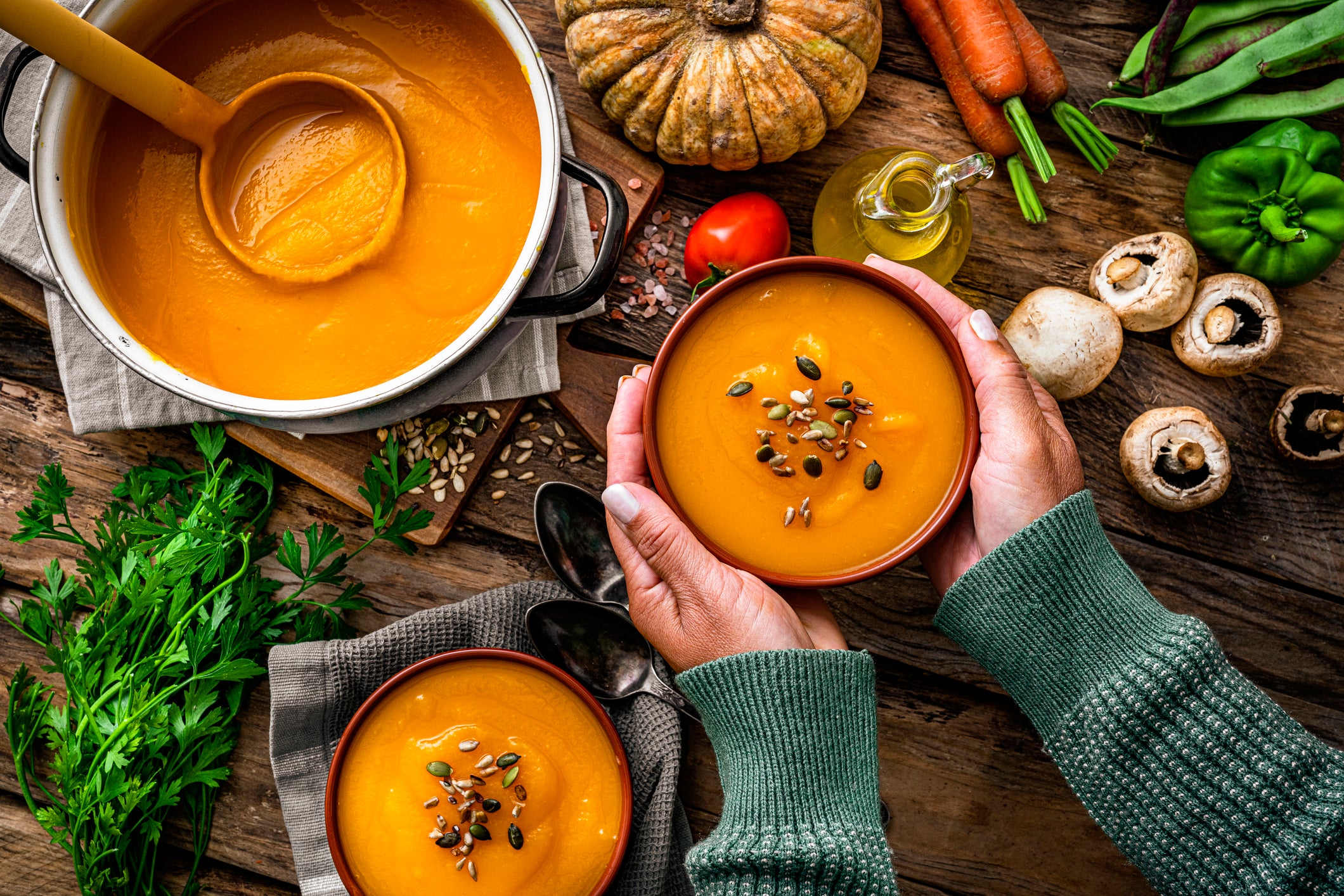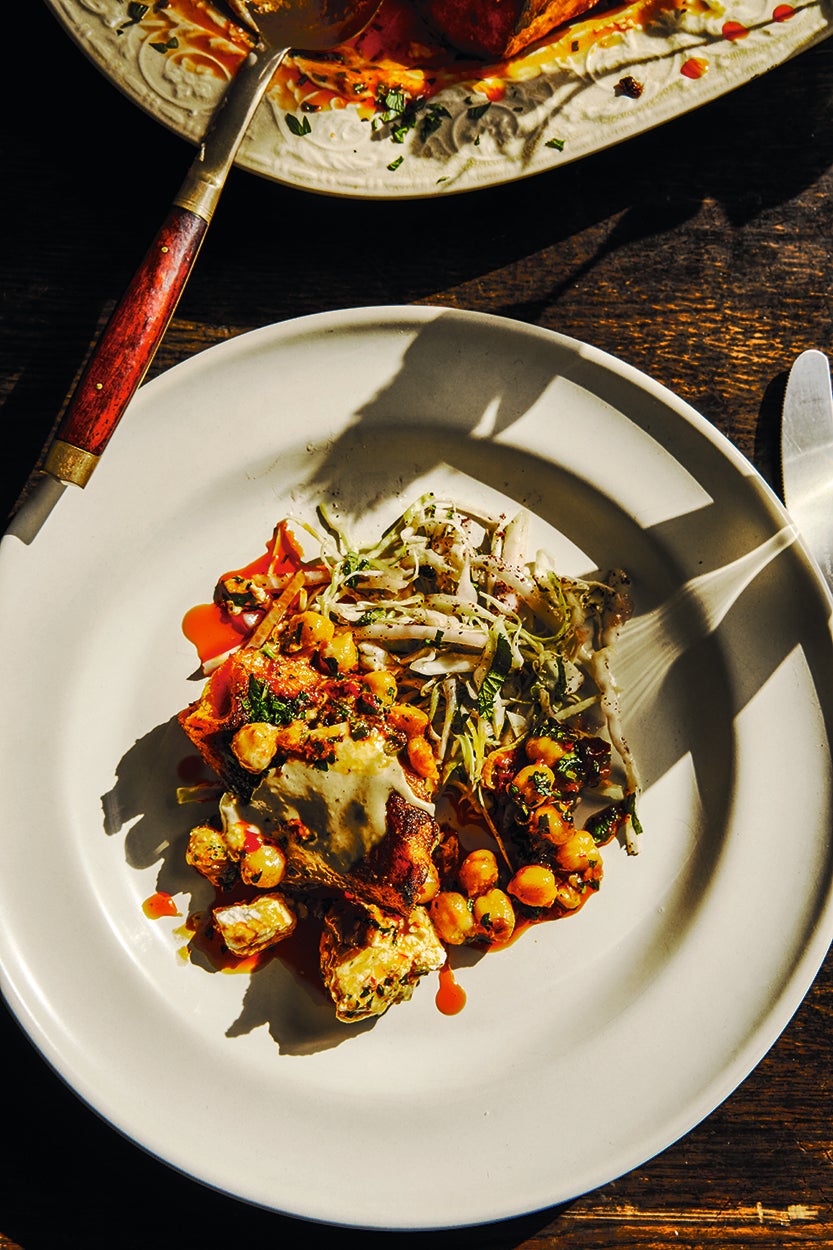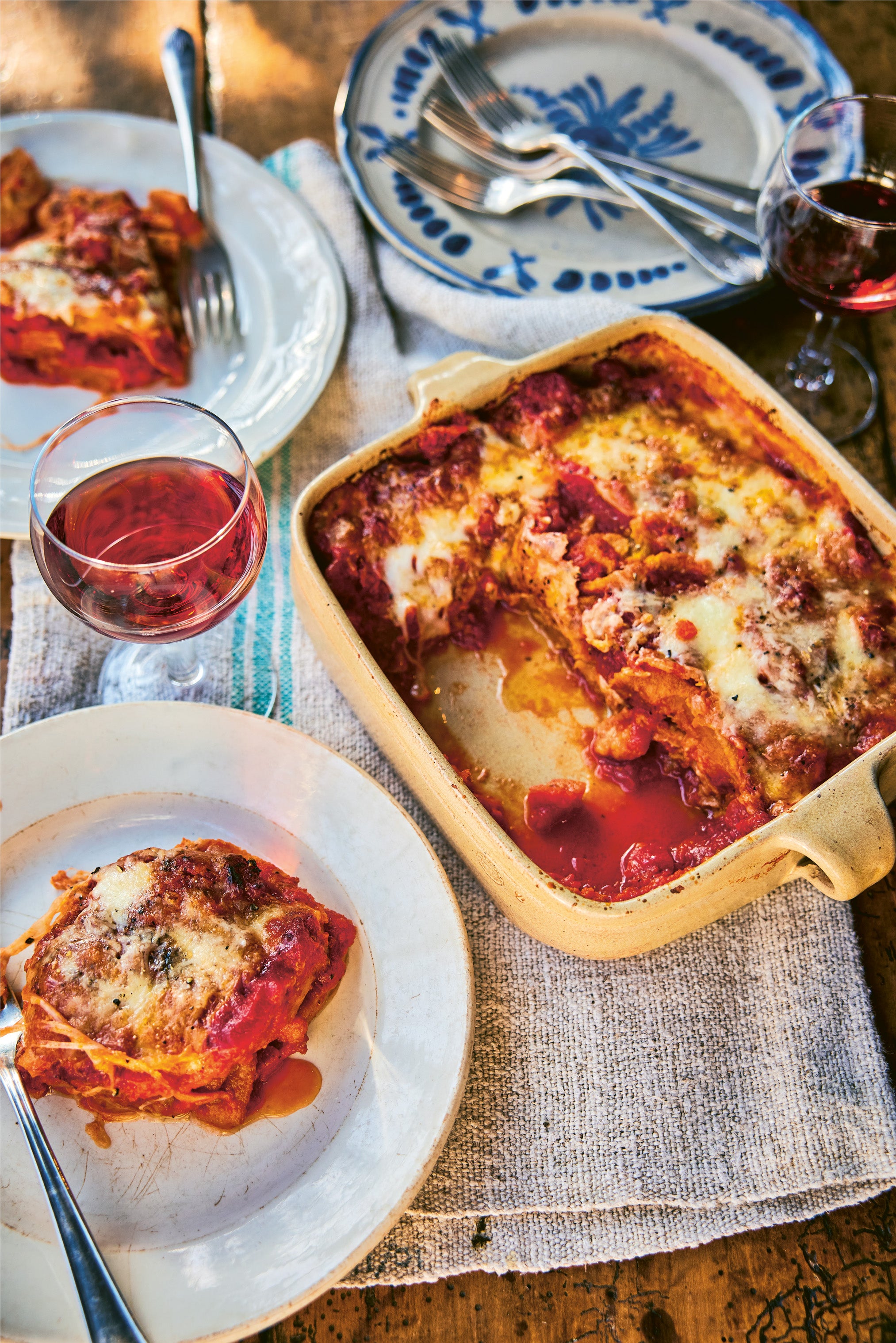Every October, millions of pumpkins grin from doorsteps across the UK – only to slump into compost a week later. According to environmental charity Hubbub, that adds up to more than 18,000 tonnes of edible pumpkin flesh thrown away each year.
Behind those flickering faces, though, lies a nutritional powerhouse: one of the world’s most nutrient-dense vegetables, rich in fibre, potassium and beta carotene. Or, as nutritional therapist at Prep Kitchen Kerry Beeson puts it, “a spooky superfood”.
“Pumpkins grown for carving are typically very large and not easy to store in the average kitchen,” she explains. “The skins are also very tough, as anyone who has tried to carve a jack-o-lantern will know, so they can be quite a chore to prepare.”
In other words, we’ve designed pumpkins to be perfect for Instagram, not for eating. It’s easy to see pumpkins as the stuff of witches and fairytales – more spell ingredient than superfood – but they really do live up to the folklore. “Pumpkin has a whole host of nutritional benefits,” Beeson says. “It contains nutrients with wound healing, antimicrobial, anti-inflammatory and antioxidative properties.”
That orange huge comes from carotenoids: the same compounds that turn autumn leaves golden. “The most well-known of these is beta carotene,” she says, “which the body converts into immune-boosting vitamin A.”
It’s also a powerful antioxidant that protects skin from oxidative stress – no wonder beauty brands are sneaking pumpkin enzymes into serums. “Lutein and zeaxanthin are other notable carotenoids in pumpkin, with specific benefits for eye health and cognitive support,” Beeson adds.
Then there’s the mineral matrix beneath that fleshy glow. “Pumpkins are mineral-rich,” she explains, “containing high levels of potassium and magnesium, along with iron, zinc and copper.” Those nutrients keep the heart strong and the immune system humming.
“Potassium and magnesium support heart health,” she adds, “by helping regulate blood pressure, maintain normal heart rhythm and promote healthy vascular function.”
And while most of us are stocking up on vitamin C from citrus, supplements and serums, Beeson says pumpkin deserves a place on your winter health roster. “Pumpkin is a great choice for your winter health menu as it also contains immune-boosting vitamin C and plant compounds called cucurbitacins, believed to have anti-cancer and anti-inflammatory properties.”
Few ingredients tick as many boxes for modern health concerns as pumpkin: immunity, digestion, metabolism, inflammation. “The soluble fibre in pumpkin acts as a prebiotic to feed your good gut bacteria,” Beeson says. “It also helps to improve digestion, keep blood sugar stable and help maintain healthy cholesterol levels.”

She highlights pectin, a type of soluble fire that “soothes and repairs the intestinal lining” while “helping to regulate blood glucose levels by slowing carbohydrate absorption”. That combination makes pumpkin a comfort food that genuinely comforts: it doesn’t just feed you, it balances your gut, your blood sugar and your mood.
Beeson adds that “around 70 per cent of our immune cells reside in the gut”, so a healthy microbiome underpins everything from resilience to viruses to mental clarity. “Fibre, particularly soluble fibre, can slow down gut transit time,” she says, “which prevents carbohydrates from being absorbed too quickly and released into the bloodstream.”
This is also where pumpkin’s potassium content shines. “Potassium helps regulate blood pressure by balancing the effects of sodium (in salt) and promoting the excretion of excess sodium through urine,” she explains. “That reduces fluid retention and lowers blood volume, and therefore blood pressure.”
It’s a trifecta most foods can’t boast: heart, gut and immune support in one sweet, velvety package.
18,000
tonnes of pumpkin wasted every year
Nutritionally, pumpkin has long lived in the shadow of its orange peers. But if you’re counting carbs or calories, it’s a quiet overachiever. “Sweet potatoes and carrots are a little more nutrient-dense than pumpkin,” Beeson says, “but pumpkin is lower in calories and carbohydrates, and is still rich in vitamin A, fibre and antioxidants.”
She points out that a 240g portion of cooked pumpkin contains only 50 calories, half that of carrots and a quarter of sweet potato. “Pumpkins have a higher water content, so they are great for hydration and keeping you feeling fuller for longer.”
That makes pumpkin an easy way to bulk out autumn meals without losing flavour or texture – think creamy risottos, velvety soups or even pureed into sauces in place of cream.
If the flesh is impressive, the seeds are nothing short of alchemy. “Pumpkin seeds are often scraped out of your jack-o-lantern and discarded, but they’re even more nutritious than the flesh,” Beeson says. “They contain protein, antioxidants, fibre and healthy fats. A handful (around 28g) of pumpkin seeds provides around 5g or protein, along with key minerals like magnesium, zinc and iron. They’re rich in healthy fats like alpha-linolenic acid, which the body can convert to essential omega-3 fatty acids.”
Roasting them not only enhances flavour but increases antioxidant activity. “Roasting pumpkin seeds actually improves their flavour, colour and digestibility while boosting beneficial compounds like phenolics, flavanoids and antioxidants,” she explains. “Research has indicated that roasting at 160C gives the best nutritional quality, with minimal changes to the essential fatty acid content and protein value.”

In other words: the bit we usually throw away may be the most nourishing part of all.
Part of pumpkin’s problem is its reputation for being awkward. “It’s safe but not advisable to eat pumpkin raw, as the flesh can be tough and bitter,” says Beeson. “Cooking softens the flesh and breaks down the structure, making it easier to digest.”
She recommends treating pumpkin like a versatile base rather than a novelty ingredient. “Pumpkin can be steamed, roasted, mashed or boiled, though as when cooking most vegetables, some heat-sensitive nutrients can be lost when heated,” she says. “Cooking in a soup or stew retains more of the nutrients in the stock, so it is a good way to enjoy the nutritional benefits.”
For the time-poor, tinned pumpkin can be a lifesaver – with caveats. “Canned pumpkin will have been processed and may have a lower nutritional value,” she notes. “They’re often canned with added salt, sugar or other additives, which will affect the nutritional profile. Canned pumpkin is quick and easy to use, however, as preparing pumpkin can take a very long time.”
Given its nutrient profile, pumpkin could be quietly transformative for many common health conditions. “Due to its high fibre and mineral content, pumpkin might help to support heart health and a healthy metabolism,” Beeson adds. “Its anti-inflammatory properties and soothing soluble fibre, especially pectin, might also offer benefits for inflammatory gut conditions.”

It’s the kind of ingredient that makes sense for everyone from athletes to those with high blood pressure or blood sugar concerns. And beyond the health benefits, there’s an environmental one, too.
“Eating seasonal foods can mean fresher, more nutrient-dense food, which has been harvested at its peak,” says Beeson. “Seasonal foods may be available locally, reducing their carbon footprint and often supporting smaller suppliers. It encourages us to vary our diet throughout the year and eat different foods to obtain a range of different nutrients.”
That, perhaps, is the real magic trick: turning a symbol of seasonal waste into one of sustainable eating.
For Beeson, pumpkin isn’t just a case study in nutrition – it’s a genuine kitchen staple. “I love roasted pumpkin in a winter salad,” she says. “Its sweet flavour pairs beautifully with dark salad leaves and it goes so well with any main dish. I also love it mashed at this time of year in hearty autumn comfort foods, like cottage pie with cheesy pumpkin mash.”
So the next time a half-carved pumpkin starts to fade on your doorstep, pause before binning it. That orange globe is more than a seasonal prop – it’s a low-calorie, mineral-rich, fibre-packed, antioxidant-loaded ingredient with real health credentials.
In the right hands, it’s less trick, more treat – proof that sometimes, the most magical foods are the ones we’ve been wasting all along.
Hearty pumpkin soup

Serves: 4
Ingredients:
3 cups of pumpkin/vegetable/chicken stock
500g pumpkin puree
Large knob of butter
1 chopped onion
2 chopped carrots
1 finely chopped garlic clove
1 cup of cream
½ tsp chopped thyme, salt and pepper
Method:
1. Melt the butter in a large saucepan, then add the garlic, onion, carrots, thyme and a pinch of salt and cook for 5-8 minutes or until softened.
2. When cooked, transfer to a food processor and blitz together with the pumpkin puree until smooth, then return to the saucepan, add in the stock.
3. Bring to the boil, then lower the heat and simmer for 15 minutes, stirring occasionally.
4. Reduce the heat to very low and add the cream and simmer for a further 5 minutes. Season to taste and serve.
Recipe from Gousto
Pumpkin ravioli with sage butter

Serves: 4
Ingredients:
4 eggs
400g “00” pasta flour
4 tsp olive oil
350g roast pumpkin flesh
100g grated parmesan
15g fresh sage
75g butter
Salt and pepper
Method:
1. For pumpkin filling: Add the roast pumpkin, grated parmesan and a big pinch of salt and pepper to a food processor and blitz until smooth.
2. For the ravioli: Add the eggs, pasta flour and olive oil to a food processor and blitz until a crumbly mixture forms.
3. Knead the mixture for 10 minutes or until it becomes smooth and elastic, then wrap in clingfilm and leave to rest for 20 minutes.
4. When ready, cut the dough into 4 pieces and roll out into thin pasta sheets (approx 2mm).
5. On one sheet, spoon out a couple of teaspoons of filling every few inches, then brush around each mound of filling with water, place the second sheet on top and cut around each mound with a sharp knife. Crimp the edges of each to seal them.
6. Repeat until all the filling or pasta sheets have been used up, then add the ravioli to a pot of boiling water for 3 minutes or until they float to the top of the water.
7. For the sage butter: Heat the butter in a frying pan until melted and foaming, then add the sage leaves and cook until the leaves crisp up and the butter browns. Season to taste, and drizzle over the cooked ravioli.
Recipe from Gousto
Pumpkin, celeriac, Gorgonzola and potato gratin with a wintery not-so-green salad

This is peak winter comfort food for me, says Mike Davies. All of your favourite winter roots baked in a luxurious yet simple sauce. A salad is the best accompaniment to this, particularly if it features the kind of heavyweight bitter leaves I’m suggesting. Bitterness is a terrific counterpoint to richness, trust me.
For the gratin:
Ingredients:
500ml double cream
500ml whole milk
1 bunch of thyme, finely chopped
10 garlic cloves, finely chopped or grated
½ nutmeg clove
1 small pumpkin, such as Delica or Violina, unpeeled, deseeded and thinly sliced
1 small celeriac, peeled and thinly sliced
2 large baking potatoes, thinly sliced
200g Gorgonzola, broken up into a small chunks
125g butter, cubed, plus extra for greasing
Salt and pepper
Method:
1. Preheat your oven to 180C fan/200C/400F/ gas mark 6 and butter an ovenproof dish or deep roasting tin.
2. Put the cream and milk in a saucepan over a low heat. Add the thyme, garlic and nutmeg, and season with salt and pepper. Heat very gently for 20-30 minutes so that all the flavours meld but do not allow the mixture to boil.
3. Build your gratin by layering up alternate pieces of the sliced roots, seasoning with a little salt and pepper as you go and dispersing the Gorgonzola and butter throughout the layers, making sure you leave a little butter and cheese for the top layer. Pour over the cream mixture and top the gratin with the remaining butter and Gorgonzola. Cover with a piece of baking paper and a layer of foil and bake for 30 minutes. Check the texture of the veg with a knife – it’s ready when there is no resistance.
4. If you’re intending to serve the gratin on the day you make it, go to the next step. If you’re making it ahead of time, allow it to cool at this point and then keep it in the fridge. To finish the gratin, remove the baking paper and foil and bake for a further 15 minutes until burnished and bubbling. If you’re reheating the gratin, it will need 30 minutes to come back to life. It may also need an additional splash of cream or milk before going back in the oven, depending on how much liquid has been absorbed.
For the salad:
Ingredients:
1 large radicchio, such as Treviso, core removed and separated into leaves
2 heads of chicory, core removed and separated into leaves
Extra virgin olive oil
Good vinegar, such as muscatel, sherry, red wine or white wine vinegar
Method:
1. This is a simple salad. Mix the leaves, dress with oil and vinegar and season to taste. You need the bitterness of the leaves shining brightly next to the earthy comfort of the root vegetable gratin. Lean into the bitterness, it’ll be very welcome.
Recipe from Cooking for People by Mike Davies (Pavilion, £30).
Roasted pumpkin, harissa chickpeas and kohlrabi slaw with tahini

If sweetcorn feels like you’re holding on to summer, pumpkin says you’re happy to embrace autumn, says Mike Davies. It’s taken me a while to truly enjoy roasted pumpkin because it all too often becomes dry through cooking, and as such can have a bit of a mealy texture. I prefer a slightly wetter textured pumpkin that stays moist when roasted. Of course you can achieve this with liberal amounts of butter or good olive oil which can help with a drier pumpkin, but some pumpkins are just naturally a bit better hydrated.
If you can find them, I love Violino pumpkins, but butternut squash will work just as well. This recipe leans towards Middle Eastern flavours, which lend themselves to vegan cookery perfectly. If I was making this in the pub, we would make our own harissa, because that’s how we roll. Feel free to DIY, but good harissa, such as Belazu’s, can be purchased in most supermarkets.
For the pumpkin:
Ingredients:
1.2kg pumpkin or squash, cut into large wedges and deseeded
1 tbsp dark brown sugar
2 tsp ground cumin
1 tsp ground turmeric
1 tsp chilli flakes
½ tsp ground cinnamon
Extra virgin olive oil
Salt and pepper
Method:
1. Preheat your oven to 200C fan/220C/425F/gas mark 7.
2. In a large roasting tin, dress the pumpkin with plenty of olive oil, making sure that there is enough to create a layer in the bottom for cooking beyond just coating the wedges. Dress the pumpkin with all of the spices and sugar before seasoning well with salt and pepper. Roast the pumpkin until it has softened and started to colour – approximately 25-30 minutes, depending on your oven and the size of your pieces.
3. When the pumpkin wedges have softened and caramelised but are still holding their shape, take the tray out of the oven and allow to cool completely before attempting to move the pumpkin. It’s a lot softer when it’s hot, and you don’t want to break it up too much.
4. It’s best to roast the pumpkin on the day of serving, but it can be done a day in advance and kept in the fridge, ideally in a single layer so as not to crush it. When you come to serve it, reheat in a 160C fan/180C/350F/gas mark 4 oven for 10 minutes to warm through.
For the harissa chickpeas:
Ingredients:
1 x 700g jar of good-quality chickpeas (Perelló, Bold Bean Co or Navarrico, for example)
2 heaped tbsp good-quality harissa
2 tbsp extra virgin olive oil
1 small bunch of parsley, finely chopped
1 bunch of spring onions, thinly sliced
Zest of 1 lemon
Salt and pepper
Method:
5. Combine the chickpeas and the liquid from the jar with the harissa and a generous amount of extra virgin olive oil – at least 2 tablespoons. This can be done ahead of time, but honestly it’s so quick, why bother? The chickpeas are cooked, so they only need to be heated through.
6. Put them in a pan on a low heat and bring to a simmer. Add the parsley, spring onions and lemon zest. Check the seasoning, it probably won’t need much as the beans are a little salty and the harissa packs quite a punch. Serve warm, right away.
For the tahini sauce:
Ingredients:
100g tahini
2 garlic cloves, finely grated
Juice of 2 lemons
300ml water
Salt and pepper
Method:
7. Put the tahini, garlic and lemon juice in a food processor and start blending, then slowly add the water. This can also be done with a bowl and a whisk. Initially it will thicken, then gradually it will start to loosen and lighten in colour.
8. Season with salt and pepper. If the mixture feels too thick, you can loosen it further with more water, just make sure to adjust the seasoning if you do. The sauce can be made up to three days in advance and stored in the fridge.
For the slaw:
Ingredients:
1 kohlrabi, cut into thin strips or grated
1 small white cabbage, finely shredded
1 bunch of mint, leaves picked and finely shredded
2 tbsp extra virgin olive oil
1½ tbsp white wine vinegar
1 tsp sugar
Sour cherry molasses (optional) – we buy ours online from Belazu, who incidentally have beautiful tahini
Salt and pepper
Method:
9. Put the kohlrabi, cabbage and mint in a bowl and dress the slaw with olive oil, vinegar and sugar. Season with salt and pepper, and add a tablespoon or so of sour cherry molasses if you’ve managed to find it. The slaw should be light and fresh, slightly acidic, slightly sweet, and not overly oily.
To finish:
Ingredients:
1 small bunch of parsley, chopped
Method:
10. Heat through your pumpkin and chickpeas if you prepped them ahead, then assemble a platter with chickpeas on the base and pumpkin on the top. Dress the whole plate with tahini sauce and sprinkle over some parsley. Plate the slaw separately and bring it to the table before having at it.
Recipe from Cooking for People by Mike Davies (Pavilion, £30).
Pumpkin parmigiana recipe

Parmigiana was originally a dish made with aubergines from southern Italy, in particular Campania and Sicily, says Gennaro Contaldo.
“Whereas aubergines are abundant during the summer, pumpkin is plentiful during the colder season, especially in rural locations where this autumnal squash provided necessary nutrition for families and so was used in a variety of dishes,” he explains.
Serves: 4-6
Ingredients:
1 x 1.4kg pumpkin (you need approx 1kg prepped weight)
3-4 eggs plain flour, for dusting
Abundant vegetable oil, for deep-frying
2 balls of mozzarella cheese (each about 125g), drained and roughly chopped
75g grated Parmesan cheese
For the tomato sauce:
2 tbsp extra virgin olive oil
1 small onion, finely chopped
3 x 400g cans chopped tomatoes
6 basil leaves
Sea salt and freshly ground black pepper
Method:
1. First make the tomato sauce. Heat the olive in a saucepan, add the onion and fry over a medium heat for about five minutes, then add the tomatoes, basil leaves and some salt to taste. Leave to simmer over a gentle heat for about 25 minutes until thickened.
2. In the meantime, peel the pumpkin, cut it in half, then into quarters, remove the seeds and then cut into slices about five-millimetres thick. Lightly beat the eggs in a shallow dish with a little salt and pepper. Dust the pumpkin slices with flour, shaking off the excess, then dip into the beaten egg.
3. Heat plenty of vegetable oil in a deep frying pan until hot, then add the pumpkin slices (you may need to do this in batches, depending on the size of your pan) and deep-fry for a couple of minutes on each side. Remove using a slotted spoon and drain on kitchen paper to absorb the excess oil.
4. Meanwhile, preheat the oven to 180C fan/200C/gas mark 6.
5. Line an ovenproof dish with a little of the tomato sauce, then place some pumpkin slices over the top, sprinkle with a little black pepper, dot around some mozzarella, sprinkle over some grated Parmesan and top with some more tomato sauce. Continue making layers like these until you have finished all the ingredients, ending with a final sprinkling of mozzarella and grated Parmesan.
6. Cover with foil and bake in the oven for 15 minutes. Remove the foil and continue to bake for a further 15 minutes until the cheese has melted and has taken on a golden brown colour. Remove from the oven and leave to rest for about 10 minutes before serving.
Recipe from Gennaro’s Cucina: Hearty Money-Saving Meals From An Italian Kitchen, by Gennaro Contaldo (Pavilion Books, £25).
Source link
The Nation’s Largest Food Aid Program Is About To See Cuts. Here’s What You Should Know.
We Asked a Dietitian How Often You Should Eat Fish for Omega-3s
November highlights the latest heart and brain health news, Diabetes, Eat Smart Month, Caregivers Month and more…